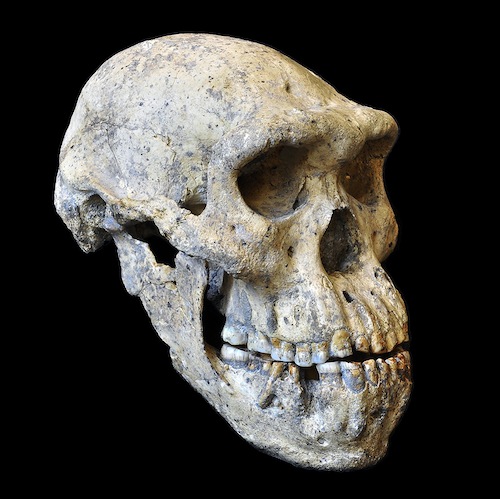 Evolution
Evolution
 Human Origins
Human Origins
Skull “Rewrites” Story of Human Evolution — Again

On what seems like a surprisingly regular basis, a new fossil turns up that “rewrites” the story of human evolution. According to news reports, the discovery of skulls thought to represent a member of early Homo at an excavation in Dmanisi, Georgia, promises to do just that. As NBC News says:
Specimens that supposedly represent several early human species might be merely different-sized individuals from the same species.
If the conclusion holds up, the skull discovery would require a major rewrite for the story of early human evolution.
So what exactly did they find? According to its discoverers, this is the skull of a previously known species (Homo erectus), from a time period when we already knew this species existed. The specimens of five individuals found in underground animal lairs (where they were evidently eaten) would represent the oldest members of Homo found outside of Africa. But as far as morphology and timing goes, the fossils contribute very little that’s “new” to the spotty standard account of human evolution.
The only reason this is making headlines is because the researchers found a few skulls in a single location, and they think they can assign them all to the same species. This excites evolutionary paleoanthropologists since usually the evidence is so sketchy you don’t even know how closely different fossils are related. So they’re very enthusiastic at the prospect of being able to assign fossils of multiple individuals found at the same locality to the same species. The fact that the ability to assign a few skulls to the same species makes headlines shows just how sketchy the story of human evolution remains.
All that said, there are of course those who disagree that these skulls all represent one species:
Arizona State University paleoanthropologist Donald Johanson, who discovered the famous 3.2 million-year-old Lucy fossil skeleton almost four decades ago, said Lordkipanidze and his colleagues have produced “a beautiful little paper” — but he doesn’t buy the claim that all of the earliest human species should be lumped together.
“I think it’s probably premature to dump everything into Homo erectus,” Johanson told NBC News. “This is what you’re going to find the most opposition to.”
Johanson said the entire collection of specimens of early Homo species from East Africa shows “considerably more variation than you see in this sample [from Dmanisi], which is not surprising, because you’re looking at fossils from very different regions.”
He said the Dmanisi skulls reminded him of Homo ergaster, an African species that’s similar to Homo erectus specimens found farther east. “It strengthens the view that many of us have held, that [Homo] ergaster was the species that got out of Africa to give rise to this Dmanisi population, and that ultimately evolved into Homo erectus in Java,” Johanson said.
Skull 5’s small braincase also raised interesting questions, because humans living in Africa during the same time period had larger brains. “That may suggest that these populations in Africa and in Georgia were under different selective pressures,” Johanson said.
He expected that “there’ll be the normal bickering” over how to classify the Dmanisi skulls. Do they represent an existing fossil species, a new species, a subspecies or a sub-subspecies? In any case, Johanson said the newly reported findings will make a significant contribution to the study of early human evolution.
Adding to this disagreement is the fact that the discoverers admitted that if the fossils had been found at different localities, they probably would have been assigned to different species. As stated in the New York Times:
Dr. Lordkipanidze and his colleagues said the differences between these fossils were no more pronounced than those between any given five modern humans or five chimpanzees. The hominids who left the fossils, they noted, were quite different from one another but still members of one species.
“Had the braincase and the face of Skull 5 been found as separate fossils at different sites in Africa, they might have been attributed to different species,” a co-author of the journal report, Christoph Zollikofer of the University of Zurich, said in a statement. Such was often the practice of researchers, using variations in traits to define new species.
Although the Dmanisi finds look quite different from one another, Dr. Zollikofer said, the hominids who left them were living at the same time and place, and “so could, in principle, represent a single population of a single species.” He and his Zurich colleague, Marcia Ponce de León, conducted the comparative analysis of the Dmanisi specimens.
Such qualifications don’t exactly inspire confidence. Indeed, Zollikofer explains that it’s not clear what these fossils mean:
“There is a big gap in the fossil record,” Zollikofer told NBC News. “I would put a question mark there. Of course it would be nice to say this was the last common ancestor of Neanderthals and us, but we simply don’t know.”
So we’re left right back where we started: lots of disagreements, a big mystery and big gaps in the fossil record. What else is new?
Photo credit: Dmanisi skull5, Guram Bumbiashvili/Georgian National Museum.
